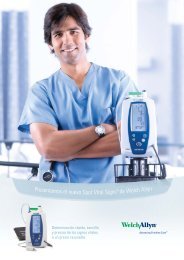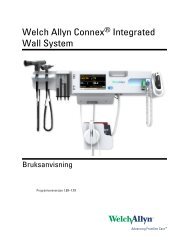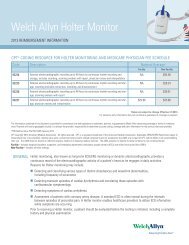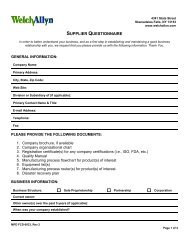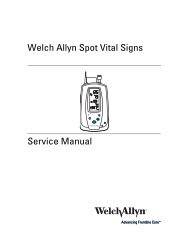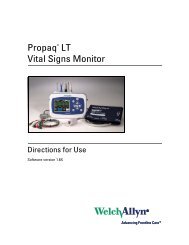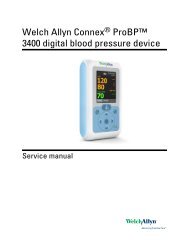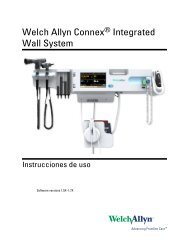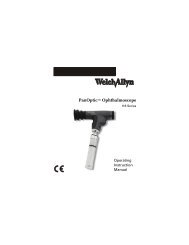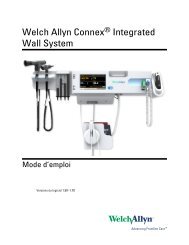MiniHolter Event ECG Recorder User Manual - Welch Allyn
MiniHolter Event ECG Recorder User Manual - Welch Allyn
MiniHolter Event ECG Recorder User Manual - Welch Allyn
Create successful ePaper yourself
Turn your PDF publications into a flip-book with our unique Google optimized e-Paper software.
<strong>Welch</strong> <strong>Allyn</strong>Staalweg 502612 KK DelftThe Netherlands<strong>Welch</strong> <strong>Allyn</strong>4341 State Street RoadSkaneateles Falls, NY13153-0220 USAwww.welchallyn.com0297Mat. 711232, Ver A
Instructions for useThe information contained in this manual is subject to change without notice.All changes will be in compliance with regulations governing manufacture of medical equipment.© Copyright <strong>Welch</strong> <strong>Allyn</strong> 2008.No part of this publication may be reproduced, transmitted, transcribed, stored in a retrievalsystem or translated into any human or computer language in any form by any means without theconsent of the copyright holder.Unauthorized copying of this publication may not only infringe copyright but also reduce the abilityof <strong>Welch</strong> <strong>Allyn</strong> to provide accurate and up-to-date information to users and operators alike.<strong>User</strong> responsibilityThis product is designed to perform in conformity with the description thereof contained in thisoperation manual and accompanying labels and inserts, when assembled, operated, maintainedand repaired in accordance with the instructions provided. A defective product should not beused. Parts that are broken, plainly worn, missing or incomplete, distorted or contaminated shouldbe replaced immediately. Should any repair or replacement become necessary, we recommendthat service be performed at the nearest factory approved service center. The user of the productshall have the sole responsibility for any malfunction which results from improper use, faultymaintenance, improper repair, damage or alteration by anyone other than <strong>Welch</strong><strong>Allyn</strong> or theirauthorized service personnel.USA1 800 5356663Australia + 6129 638 3000+ 1 315 685 4560Canada 1 800 561 8797 China + 86 216 327 9631European Call Center + 353 46 906 7790 France + 3315 569 5849Germany + 49 747 792 7186 Japan + 8133 219 0071Latin America + 1 305 669 9003 Netherlands + 3115 750 5000Singapore + 656 419 8100 South Africa + 2711 777 7555United Kingdom + 44 207 365 6780 Sweden + 46 85 853 6551Mat. 711232, Ver A 2
Contents1. GETTING STARTED ...................................................................................42. RECORDING A MINI HOLTER EVENT <strong>ECG</strong> TEST....................................42.1 Recording a retrospective test ...............................................................5Create a new retrospective test .............................................................6Prepare the recorder..............................................................................8Connect the recorder to the patient......................................................10Start the recorder.................................................................................112.2 Read back recordings ..........................................................................11Mat. 711232, Ver A 3
1. Getting startedRefer to the HR100/HR300/HR1200 Instructions For Use for detailed information on the HR300Holter <strong>Recorder</strong>.2. Recording a mini Holter <strong>Event</strong> <strong>ECG</strong> testThe <strong>Welch</strong> <strong>Allyn</strong> Mini Holter <strong>Event</strong> <strong>ECG</strong> System easily records ambulatory <strong>ECG</strong> tests. Use thetwo channel retrospective mode.Memory CardThe removable Memory Card stores up to 90 minutes of two channel data recordings.Retrospective modeYou can use retrospective mode if:• the patient has rather frequent symptoms.• you want to record the onset of an event.Monitoring can last from a few days up to a few weeks. You can freely adjust the amount of <strong>ECG</strong>recorded before and after activation. It is only limited by the capacity of the Memory Card that isused.In a retrospective test the patient wears the recorder for a certain period. The recorder isconnected to the patient with special long term electrodes. It continuously records <strong>ECG</strong> into aloop of memory until the patient feels an irregularity in his heartbeat and chooses to make arecording. When the patient activates the recorder by pressing the button, <strong>ECG</strong> is stored fromboth before and after activation.Retrospective testsThe HR300 Holter <strong>Recorder</strong> does not support Recordings at specific times.Retrospective mode is commonly used to record two channels of <strong>ECG</strong>, enabling betterdiscrimination of cardiac rhythm and conduction.Mat. 711232, Ver A 4
2.1 Recording a retrospective testTo record a test in retrospective mode, you need to follow these global steps. Steps 2, 3, 4, 6and 7 are explained in more detail on the following pages.1) Place the memory card in the card reader that is connected to your computer.2) Select a patient or create a new one.3) Create a new test.Note: If the patient's symptoms require a large series of recordings, you can supply himwith more than one Memory Card. You then need to store the test settings on all cards,which means that you have to create the same test more than once, each time with anew card in the card reader.4) Prepare the recorder before connecting it to the patient.5) Place the Memory Card in the recorder (note the arrow). Push the card fully in.6) Connect the recorder to the patient.7) Start the recorder.8) The patient carries the recorder with him for some time. To ensure that the recorder willrecord properly, you may need to give the patient a sheet with a few instructions (See theappendix; you can make a copy of it).9) When the patient returns, place the Memory Card in the card reader again and read backthe recordings.Mat. 711232, Ver A 5
Create a new retrospective testBefore you can record a retrospective test, you first need to create a new test. The test settingsare stored on the Memory Card that you put in the card reader that is connected to yourcomputer.Note: If the patient's symptoms require a large series of recordings, you can supply him with twoMemory Cards. You then need to store the test settings on two cards, which means that you haveto create the same test twice.To create a new retrospective test::1. In the File menu, point to New and click Recollect test. The New Recollect Test dialogbox is displayed.2. Select the physician that ordered the test and a specialty. Click Next. The Recording tabis displayed.Note: The card capacity value is 2 times the actual recording time3. Select Retrospective Mode as recorder mode.Mat. 711232, Ver A 6
4. Select Two Channels.5. Set the <strong>ECG</strong> Recording Times. The Possible Recordings field shows how manyrecordings of the selected duration can be stored on the Memory Card and the Utilizationfield shows how much of the card capacity will be used.6. Click OK. The test settings are now stored on the Memory Card.Set <strong>ECG</strong> recording timesWhen you create a retrospective <strong>Event</strong> <strong>ECG</strong> test, you need to set these <strong>ECG</strong> recording times.You can do this in the New Recollect Test dialog box.1) In the Recording Duration field, enter the total time <strong>ECG</strong> is stored when the patientmakes a recording. You can enter the time value in two ways: the number of seconds orthe number of minutes.Example:The total recording duration is one minute.If you want to enter the value in... Type...seconds 60minutes 1:002) In the Pre-Trigger Time field, enter the time <strong>ECG</strong> is stored before the patient presses therecord button. You can also set the pre- and post-trigger time by using the slide bar.Note: The total amount of time before and after the button press always equals the totalrecording duration. When you have entered the pre-trigger time, the post-trigger time isautomatically determined.Save test settingsAfter setting the test settings, you can save them. The settings are saved on your computer, sothat you can use them again for another test.To save the test settings:1) In the New Recollect Test dialog box, click the Save As button. The Save Schemedialog box is displayed.2) Enter a name for the settings and click OK.Mat. 711232, Ver A 7
Prepare the recorderRefer to the HR100/HR300/HR1200 Instructions For Use for detailed information on preparing theHR300 Holter <strong>Recorder</strong>.Before you can place the Memory Card with the stored settings in the recorder, you have toprepare the recorder:• provide the recorder with a fresh set of batteries.• attach the patient cable.• check if the recorder displays the correct time and date.Fit the batteries1. Hold the recorder with its underside facing you. Remove the battery cover by pressingdown on the finger grip and sliding off.2. Put in two AA/MN1500 alkaline batteries (Duracell or Procell). Note the correct polaritywhen inserting the batteries.3. Replace the battery cover by sliding it until the catch engages.Attach the patient cableRefer to the HR100/HR300/HR1200 Instructions For Use for detailed information on attaching thepatient cable to the HR300 Holter <strong>Recorder</strong>.Note:• Do not attach any other type of cable to the recorder.• Do not attach the patient cable electrodes to any other electrical device.Check the time and dateThe recorder has a built in calendar and clock that are used to record the time and date on theMemory Card each time a recording is made. Therefore, make sure the recorder is set at thecorrect time and date.1. Remove the Memory Card (if fitted).2. Insert batteries.3. Adjust the time if necessary.Mat. 711232, Ver A 8
Adjust the time and dateRefer to the HR100/HR300/HR1200 Instructions For Use for detailed information adjusting timeon the HR300 Holter <strong>Recorder</strong>.To adjust the time and date by using the Memory Card and the <strong>Event</strong> <strong>ECG</strong> Systemsoftware:1. Place the Memory Card in the card reader.2. In the Tools menu, select Set recorder Date/time. The Configure the Recollectrecording device dialog box is displayed.3. Insert an empty Memory Card into the reader. Click Next.4. Set a date and a time in the near future. Click Next.5. Put the card in the recorder. Click Next.6. Start the recorder at the specified time. The recorder now displays the correct time anddate. Click Next.7. Click OK.Mat. 711232, Ver A 9
Connect the recorder to the patientIn a retrospective test, the patient wears the recorder constantly during a certain period.Therefore, you have to connect the recorder to the patient.To connect the recorder to the patient:Refer to the HR100/HR300/HR1200 Instructions For Use for detailed information on patientpreparation using the HR300 Holter <strong>Recorder</strong>.1. Put recorder into the carrying case. The record button should be visible through the cutoutin the case. The LCD should be visible through the plastic window of the case.Note: Do not press the record button when inserting the recorder.2. If the two channel cable is being used, secure the yoke to the patient body.. Thisprevents signal artifact which can result from the leads pulling on the electrodes.3. Prepare the patient's skin. Make sure it is thoroughly clean and dry so that the electrodeswill adhere well for a long period without causing irritation.4. Place the electrodes and attach the snap connectors on the lead wires at the positionsindicated by the illustrations.Note: Use Medicotest VLC-00-S electrodes (and other soft gel types). These electrodesgive good results, particularly when the patient is active.Two channels:5. You can now start the recorder.Mat. 711232, Ver A 10
Start the recorderDuring a retrospective test, the patient wears the recorder constantly. Therefore, you haveconnected the recorder to the patient. Now you have to start the recorder so that a continuousloop of <strong>ECG</strong> will be recorded.To start the recorder:Refer to the HR100/HR300/HR1200 Instructions For Use for detailed information on starting theHR300 Holter <strong>Recorder</strong>.2.2 Read back recordingsWhen the patient has returned with the recorder, you need to read back the recordings from theMemory Card and transfer them to your computer. Once you have transferred them to yourcomputer, you can view them with Mini Holter <strong>Event</strong> <strong>ECG</strong> System.To read back recordings:1. Remove the Memory Card from the recorder and put it in the card reader that isconnected to your computer.2. Select the patient who made the recordings.3. From the test list, select the test the recordings belong to. <strong>Event</strong> <strong>ECG</strong> System shows thatthe test is in progress.4. Click Actions > Retrieve Data. The Retrieve test from Memory Card dialog box isdisplayed.5. If you want to preview the recordings before you transfer them to your computer, click thePreview button.6. Click the Retrieve button to transfer the recordings to your computer.Note:• If you click Cancel, the recordings are not transferred, but left on the card.• If you click Clear, the recordings (not the test settings) are deleted from the card. Therecordings are not transferred to the computer.7. Now you can view the recordings.Mat. 711232, Ver A 11



